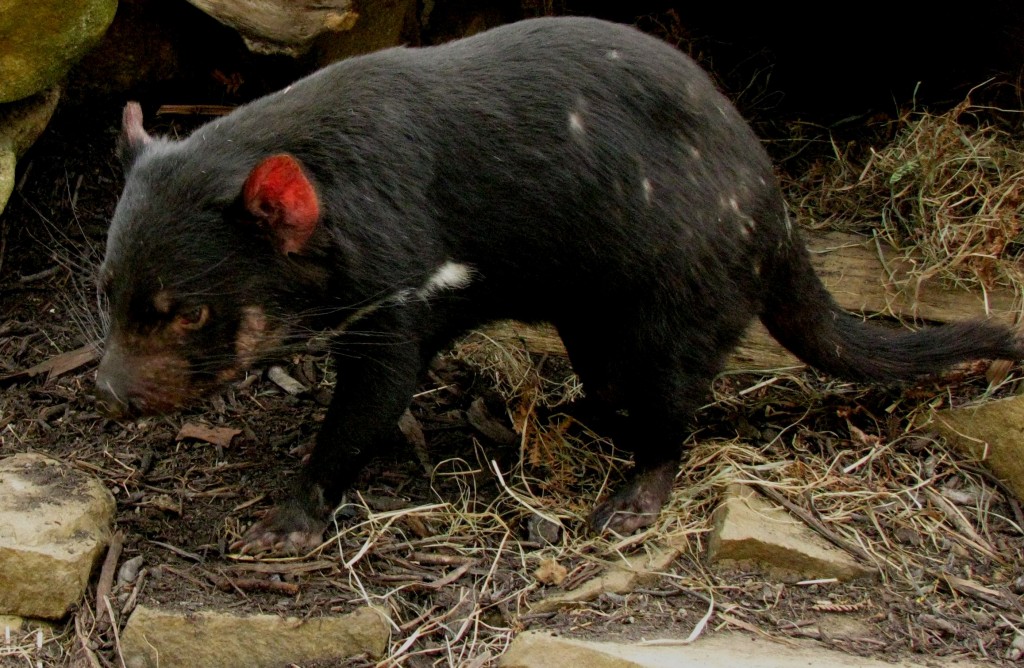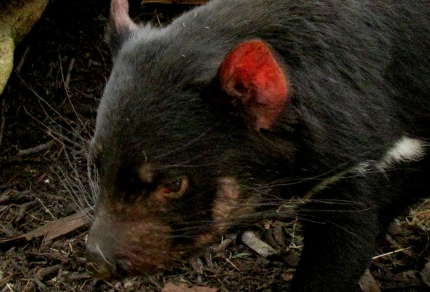Inspired by the fun of last evening’s night walk, I strolled peacefully beside the golf course early this morning before embarking on a marathon of writing and photo insertion to complete the last two posts from Vilis’s and my adventures in Tasmania. All day, for far more hours than I should have, I worked at my desk, quickly pulling down the blind to eliminate sun and distractions. I relived our hikes to rugged Seager’s Lookout on Mount Field, to the serene beauty of Russell Falls, and among the giant swamp gums in the Styx Valley. Then, on the last post, well after supper, I inserted photographs of Tasmanian devils into too brief a story (we had only 40 minutes in the Tasmanian Devil Conservation Park), and determined that Tasmanian devils deserved more coverage. Hence this brief post for today. (See also my post from the devil park at http://maginams.ca//2010/03/26/)

Tasmanian Devil (©Vilis Nams)
Tasmanian devils bear the scientific name of Sarcophilus harrisii (“Harris’s flesh lover”) and are the largest living marsupial carnivores.1 They are, however, only one of a whole suite of carnnivorous marsupials belonging to the family Dasyuridae. That familiy also includes the eastern quolls we spotted at night in Freycinet National Park, plus other quolls and a bewildering collection of smaller, primarily insect-eating carnivores I didn’t even know existed – the antechinuses and phasogales, the planigales and ningauis, the dunnarts and kultarr.2 Their names read like anatomical structures and foreign foods.
Active mostly at night, but also at dusk and dawn,1 Tasmanian devils are scavengers and hunters strong and fast enough to bring down a pademelon or small wallaby.3 They once inhabited much of mainland Australia, but are now confined to Tasmania,1 where wild populations have recently been decimated by a transmissible form of cancer known as Devil Facial Tumour Disease or DFTD.4 Devils prefer their own company, but groups gather at carcasses of dead animals and squabble loudly over the remains5, as we witnessed at the Tasmanian Devil Conservation Park. When foraging, devils lope along roadsides searching for roadkill and patrol the bush or beaches for carrion or potential prey.5 A single devil is able to consume an astonishing 40% of its weight during one night of feeding6, and devils eat every single bit of their prey,6 thus cleaning up a lot of rotting, stinking animal bodies.
Devils are most commonly found in dry forests – like that surrounding Lake St. Clair, where we heard them snarling in the night – and in coastal woodlands, especially those that abutt grasslands.7 Although we saw no sign of devils at Narawntapu National Park, with its coastal strip of forest and its plain grazed by macropods and wombats, that is apparently prime devil habitat.8 When not active, devils rest in burrows in the bush.9
By 11:30 p.m., I was ready for rest, too. The Tasmania posts were complete. Tomorrow, I would celebrate.
References:
1. M. Jones. Tasmanian Devil. In: Ronald Strahan, editor. The Mammals of Australia. 1995. Reed New Holland, Sydney. p. 82
2. Ronald Strahan, editor. The Mammals of Australia. 1995. Reed New Holland, Sydney. pp. 52-158.
3. Jones pp. 83-84; also Peter Menkhorst and Frank Knight. 2004. A Field Guide to the Mammals of Australia, 2nd edition. Oxford University Press, Melbourne. p.46.
4. Adam Bostanci. 18 February 2005. A Devil of a Disease. Science 307: 1035. Accessed 26-Jan-2010. www.sciencemag.org
5. Jones, p. 83-84; 6. Ibid, p. 84; 7. Ibid, p. 82.
8. James Woodford. 2001. The Secret Life of Wombats. Text Publishing, Melbourne. Chapter 11: The Devil’s Kitchen, pp. 191-203.
9. Jones, p. 82.


